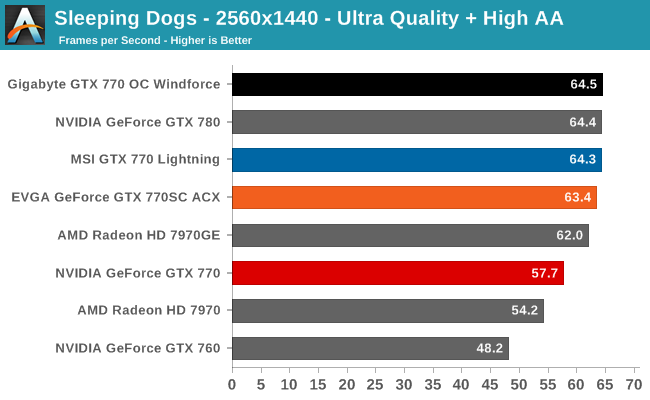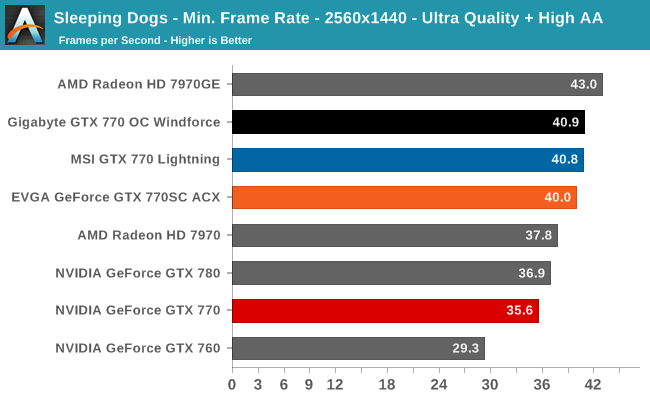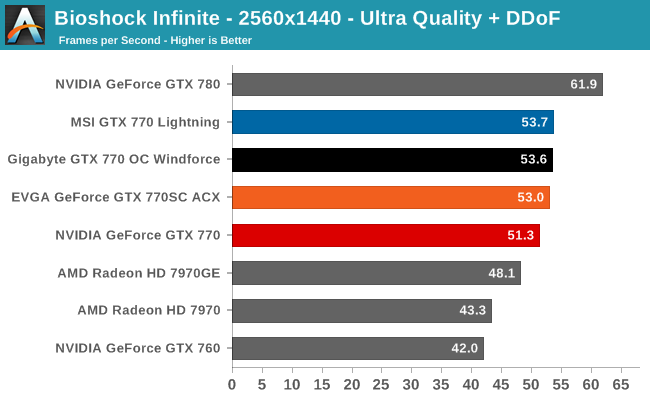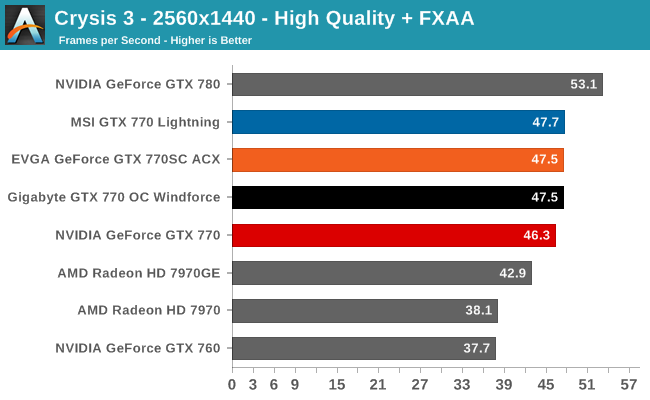The GeForce GTX 770 Roundup: EVGA, Gigabyte, and MSI Compared
by Ryan Smith on October 4, 2013 9:00 AM ESTSleeping Dogs, Bioshock, & Crysis 3


Moving on to Sleeping Dogs and its resource heavy SSAA implementation, we finally see the factory overclocks on these cards start to spread their wings, and in the process we see the cards separate themselves a bit. The fastest card by a nose is the Gigabyte 770OC Windforce, which picks up 11%. This is actually better than the Gigabyte overclock, which points to thermals also playing a factor. The MSI card follows, also at 11%, and finally the EVGA card 1fps back at 10%. It’s unfortunate for all 3 vendors that their factory overclocks aren’t this potent in every game, as these are the kind of results that help their customized cards stand out.

With Bioshock we’re back into the previous pattern of limited performance gains over a stock GTX 770, again likely due to memory bandwidth limitations. Gigabyte is once more technically the leader of the pack at 4%, but with EVGA and MSI only .2fps back it’s for all practical purposes a tie.

Our final game, Crysis 3 matches our earlier pattern of very limited gains over the stock GTX 770. At 47.7fps, the MSI GTX 770 Lightning takes an insignificant .2fps lead over the other cards in this roundup, with the overall performance gains amounting to just 3% over a stock GTX 770.
What’s clear from all of this is that EVGA, MSI, and Gigabyte are not going to be able to sell themselves on their factory overclocks alone. There are performance gains to be had, but outside of one game (Sleeping Dogs) the gains are only a few percent, which translates into just a frame or two per second in most cases. The fact that EVGA and Gigabyte aren’t charging extra for their designs is in retrospect a wise move here, as it would be difficult to charge anything meaningful for these factory overclocks given the very small performance increases. At least as far as stock performance is concerned, to differentiate themselves all 3 companies will need to rely on differentiation in their coolers, software, and support.










55 Comments
View All Comments
Ryan Smith - Friday, October 4, 2013 - link
We're not setup to review open loop coolers. However the new testbed will be able to accommodate GPUs with closed loop coolers, such as the Asus Ares.Hrel - Friday, October 4, 2013 - link
I am just endlessly impressed with Gigabyte. The consistently offer a performance to value ratio that is either the best or among the best and they do so at very competitive prices even without discounts and sales. When their products do go on sale they're simply unbeatable. I can't wait to see them expand into more categories.Hrel - Friday, October 4, 2013 - link
Also, their reliability is flawless and their support is top notch.Anandtech, when are you going to update your comment section? We REALLY need more features. The ability to edit comments, notifications via email when people respond. These are BASIC things.
Edkiefer - Friday, October 4, 2013 - link
This is one time for MSI, it probably just pays to get MSI Gaming N770 TF 2GD5/OC model as you mention 770 are pushed to limit already . The MSI gaming N770 TF is same price as others 399$RadiclDreamer - Friday, October 4, 2013 - link
I've been waiting for some time for a review that includes the 4GB version as well, any chance of that happening?Kevin G - Friday, October 4, 2013 - link
8.2 Ghz is very impressive for a memory overclock. I'd love to see such speeds on Ttian or the R9 290x for the extra bandwidth. That'd get you 524 GB/s bandwidth on the R9 290x which should be very beneficial for 4k gaming. Of course this is wishful thinking as going with a wider bus often limits memory bus speeds, but one can dream right?The Von Matrices - Saturday, October 5, 2013 - link
The problem is that the wider you make the memory bus the harder it is to route the traces on the PCB to allow high-frequency operation. AMD is only shipping the R9 290X at around 5GHz memory, and you can bet that in order to save on costs they won't be using higher rated memory chips. It might take custom PCBs before different memory chips are used, and AMD isn't allowing vendors to customize the card at all at launch.hulu - Friday, October 4, 2013 - link
You can use MSI Afterburner on any AMD/NVidia based graphics card regardless of vendor. Only thing you lose by going non-MSI non-reference board (like the Gigabyte of this roundup), is voltage control, but that is limited on these GTX 700 series cards anyway.wsaenotsock - Friday, October 4, 2013 - link
Maybe I missed it, but where the hell is the test system's information, or did including that information go out of style..iTzSnypah - Friday, October 4, 2013 - link
I think that to truly test the effectiveness of each cooler the noise and temperature graphs should use the reference clocks.